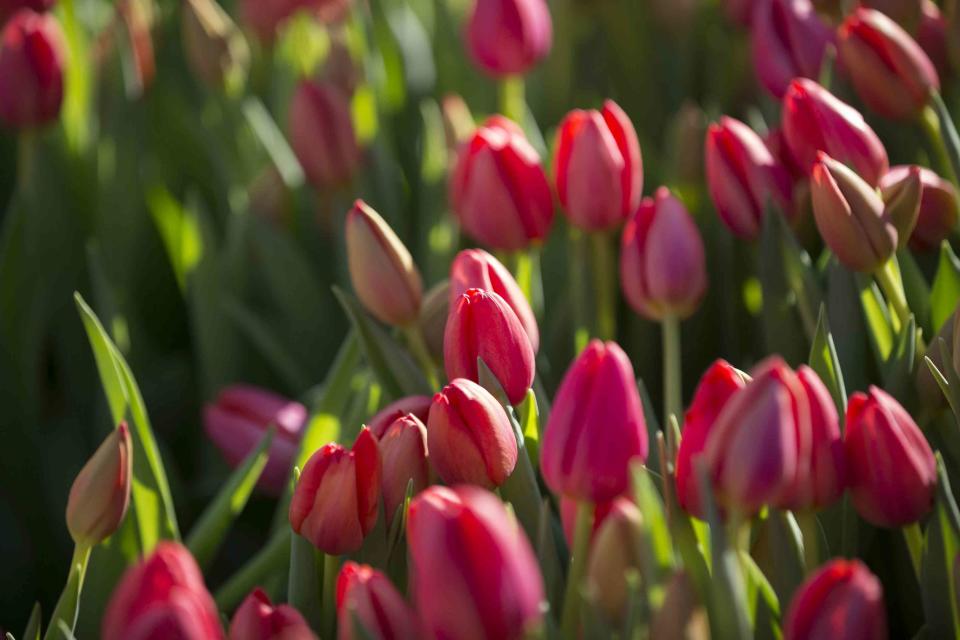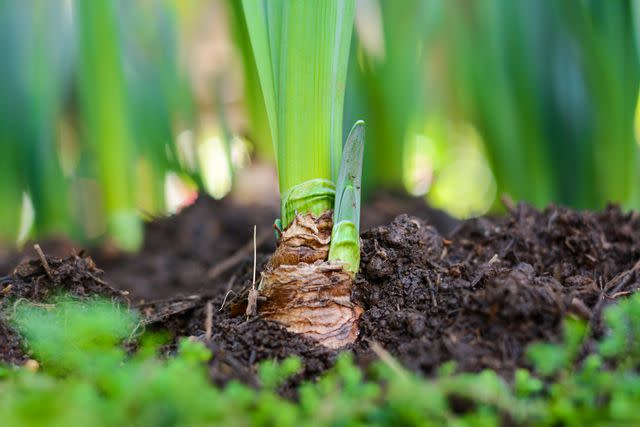How to Grow and Care for Tulips, the Low-Maintenance Spring Bloomer Every Gardener Should Plant
These colorful flowers are a sign that spring has arrived.

One of the most universal signs that spring has arrived is the resurgence of tulips. The brightly-colored perennial is hardy in zones 3 to 8 and has about 3,000 varieties in its genus with species ranging in height, petal count, and color. Its abundance is largely due to the fact that tulips are one of the most notoriously easy plants to grow—plus, they return year after year to put on a beautiful show. If you’re ready to plant this repeat bloomer in your own garden, you’ll need to know the ins and outs of how to grow and care for it.
Related: How to Plant a Perennial Garden, From Choosing a Location to Ensuring Your Blooms Return Next Year

How to Plant Tulips
Tulips aren’t usually grown from seed; instead, they're purchased as bulbs from your local garden center. "You can buy tulips in pots in the spring, but this is expensive, and you won't have the choice of varieties that suppliers of 'dry' bulbs offer in the fall," says Edwin Visser, director of merchandising at Breck's Holland. If you buy tulips in pots, you should continue growing them as container plants, as the ground could be too cold for the unestablished plants.
Planting them in the ground as bulbs is your best bet. Keep in mind though, that you may need to buy new bulbs periodically, since some varieties will only flower for three to 10 years. Plant bulbs in the fall about six weeks before your area’s first frost.
Choose a location with adequate sun and well-drained soil.
Dig a hole that’s 3 times as deep as the bulb is tall.
Plant the bulb in the hole with the pointy side up.
Backfill the hole in with soil.
Water thoroughly.
How to Care for Tulips
Despite having a reputation for being low maintenance, tulips do require some routine care.
Sun
Tulips prefer moderate temperatures: full sun in cooler climates where the sun provides additional warmth and partial shade in hotter areas. If they are in a climate where they require full sun, make sure they get at least six hours of bright light each day.
Soil
While tulips aren’t too picky with their soil, they generally prefer a sandy loam with a neutral pH. “Average garden soil is generally fine as long as it drains well,” says PeggyAnne Montgomery, horticulturist and bulb expert for Flowerbulbs.com.
Water
After planting, tulips will need one thorough watering to help them get established. But keep in mind that they are sensitive to wet soil, and aside from real drought conditions, should not be watered beyond annual rainfall. "Excess water often causes rotting," says Chad Husby, Ph.D. and chief explorer at Fairchild Tropical Botanic Garden.
Temperature
Tulip bulbs need a chilling period of about three months in order to re-bloom. "In cold climates (USDA hardiness zones 4 to 7), this can be done in the ground or in an outdoor storage area," says Husby. "In hotter climates (like zones 8 to 10), they should be refrigerated for three months before planting."
Discover Your Garden Zone Here
Fertilizer
Tulips don't require fertilizer, but if you want to give your blooms a boost, do so at the time of planting. "It is best to use a bulb formulation that is low in nitrogen," says Husby. "This helps them to build up reserves for the next season, though they already have what they need stored in their bulbs for the current blooming season."

Atstock Productions / GETTY IMAGES
How to Grow Tulips in Containers
Tulips can also be grown as container plants. For this, use any pot that's about 1-foot in diameter or larger. "Smaller pots just dry out too quickly," says Montgomery. To create the best display, plant multiple bulbs about one inch apart in the same container so it looks full.
Fill the container with potting soil.
Dig a hole that's 3 times as deep as the bulb is tall.
Repeat in the same pot for the other bulbs you want to plant.
Back fill in the hole with water soil.
Water thoroughly.
How to Propagate Tulips
Propagating tulips in a home garden isn't very common, but it can be done. "The bulbs will produce bulblets—very small bulbs that form attached to the main bulb," says Montgomery. "You then dig up the bulb, break away the bulblets and replant both." Because of how much digging is involved (plus the fact that you have to disturb established tulips) most home gardeners let their tulips spread on their own.
How to Prune Tulips
One reason tulips are considered low maintenance is because they typically don’t require any pruning. However, you can snap off spent flowers so the bulb doesn’t put energy into producing seed. “Let the bulb foliage die back (turn yellow) before removing it,” says Montgomery.
Types of Tulips
While there are many different types of tulips (each with their own unique characteristics), there are a few well-known types that are particularly beloved by avid gardeners.
Darwin Hybrid Tulips
Double or Peony Tulip
Fringed Tulips
Fosteriana Tulips
Greigii Tulips
Kaufmanniana Tulips
Lily-Flowered Tulips
Parrot Tulips
Species Tulips
Triumph Tulips
Related: These Are the Defining Characteristics of the Most Popular Types of Tulips
Common Problems With Tulips
There are a few common problems you may encounter while growing tulips, but luckily they're easy to manage.
Insects
Aphids and mites are two insects you may encounter on the foliage of your tulips. To treat these, rub the leaves gently with horticultural oil. You may also find caterpillars, snails, and slugs bothering your tulips. These can simply be hand picked off the foliage whenever you spot them.
Pests
Animals like voles and groundhogs can be a reoccurring issue for gardeners growing tulips. You can prevent this by laying sharp gravel around the base of your plants as a deterrent. "Start with gravel in the bottom of the hole, then place soil immediately around the bulbs. Finish with a layer of gravel all around the bulb, creating a protective shield," says Montgomery.
If this doesn't work, consider using chicken wire to protect your tulips. "After planting and covering bulbs with soil, cut a piece of chicken wire or hardware cloth to the size of the planted area," says Montgomery. "Secure the wire to the ground with landscape pins or large rocks." This will deter digging animals from accessing the bulbs. Note that the wire must be removed in spring when the bulbs begin to emerge.

